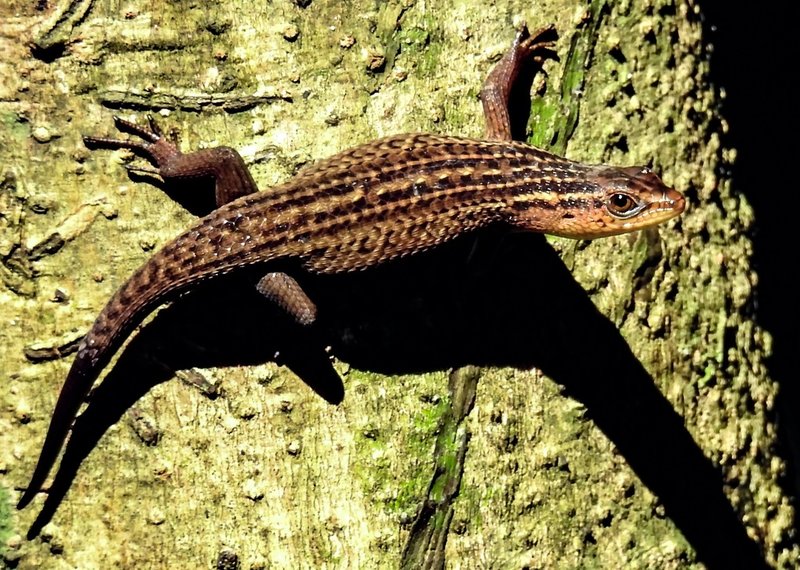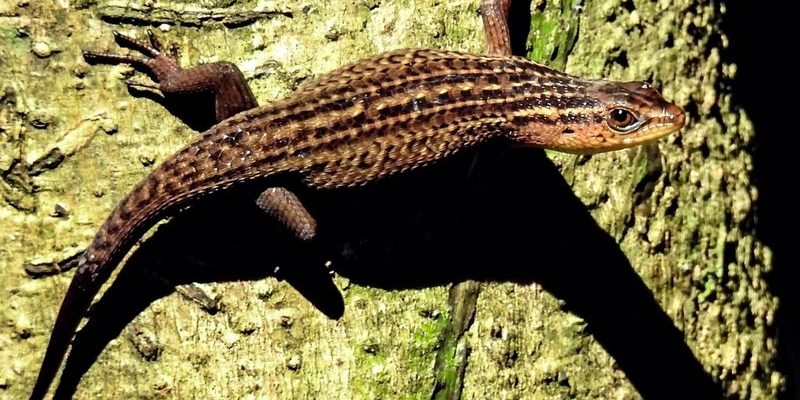
When you think about reptiles, skinks might not be the first creature that pops into your mind. These lizards belong to the family Scincidae, which is quite vast, boasting over 1,500 species! Skinks are known for their elongated bodies, short legs, and smooth, shiny scales. Imagine a little creature that looks like it has been streamlined through evolution—this is what a skink feels like as it slithers around its habitat.
They’re found on every continent except Antarctica, adapting to various environments from forests to deserts. Each species has its unique characteristics, but there’s something universally fascinating about these lizards. Their variability in size, color, and habitat means there’s a lot to learn about them.
You might be thinking, “Why should I care about skinks?” Well, they play a crucial role in their ecosystems! Skinks help control insect populations and serve as food for larger predators. Plus, they exhibit some interesting behaviors that are worth diving into!
Physical Characteristics of Skinks
Skinks come in all shapes and sizes, which makes them even more intriguing. Their bodies are typically more streamlined than other lizards, enabling them to dart through underbrush and quickly escape predators. Most skinks feature smooth, shiny scales that can vary in color from earthy browns and greens to bright blues and yellows, depending on the species.
One of the most distinct features of skinks is their short limbs. Some skink species have even evolved to have no legs at all, making them resemble snakes. For example, the glass skink is a legless skink, showcasing a fascinating evolutionary adaptation. It’s remarkable how these creatures can adjust their physical attributes to thrive in their environments.
In terms of size, skinks can range from a mere few inches to over three feet long! The largest skink is the Guam skink, while the smallest might be the Scincus scincus, also known as the sandfish. This diversity in size and appearance makes them one of the more colorful characters in the reptile kingdom.
Habitat and Distribution
Skinks are remarkably adaptable, found in a wide variety of habitats around the globe. You can see them in tropical rainforests, savannas, grasslands, and even arid deserts. They often seek refuge under rocks, logs, or leaf litter, where they can stay hidden from predators and harsh weather conditions. You may find the blue-tailed skink basking in the sun on a warm rock, showing off its vibrant blue tail as a warning to potential threats.
Just think of skinks as the ultimate survivors. Their ability to thrive across different terrains means that they have various adaptations to suit their environments. For instance, desert dwellers tend to have lighter coloring, which helps them blend into sandy surroundings, while forest skinks often exhibit dark or mottled patterns that mimic tree bark or shadows.
Geographically, skinks are present in all parts of the world except for Antarctica. Australia is known for its rich diversity of skink species, including some that display unique behaviors, such as social living and complex courtship rituals. This geographic diversity coupled with varied habitats contributes to the fascinating adaptability of skinks.
Diet and Feeding Habits
Skinks are generally insectivorous, meaning they primarily feed on insects. Their diet can include a mix of beetles, ants, and other small arthropods, which provides them with essential nutrients and energy. A healthy skink is often an active skink! Some larger skink species are known to eat small vertebrates, including other lizards and even small mammals.
What’s interesting about skinks is their hunting strategy. They often use their speed and agility to catch prey rather than waiting quietly. When hunting, skinks display quick flicks of their tongue to catch scents and locate food. This method is akin to how we might use our sense of smell to find a delicious meal in the kitchen!
In captivity, skinks can adapt to diets that include commercial insect feeders like crickets and mealworms. Just like us, they require a balanced diet for optimal health. Some might even enjoy a little fruit or vegetable as a treat! However, it’s essential to ensure they’re eating the right nutrients to keep their scales shiny and their energy high.
Behavior and Social Structure
Skinks exhibit a mix of solitary and social behaviors. While many species are primarily solitary, some have interesting social dynamics. For example, certain skinks can live in small groups, where they engage in social interactions like basking together or even grooming one another. This behavior can be reminiscent of how we gather with friends on a sunny day at the park.
Communication among skinks can include color displays, body language, and vocalizations. The vibrant coloration in some species may serve as a warning to other animals or a signal during mating rituals. It’s fascinating how they use their appearance to convey messages, much like how we might dress to express our mood or personality.
Another unique behavioral trait is the ability of some skinks to drop their tails when threatened. This method, known as autotomy, can distract predators long enough for the skink to escape. Think of it as a clever escape maneuver that highlights their resilience. The tail can even regenerate over time, making it an incredible adaptation for survival.
Reproduction and Lifespan
Skinks have diverse reproductive strategies, often depending on their species and environmental conditions. Most skinks lay eggs, but some give birth to live young. This adaptation can be crucial in environments where the temperature for egg-laying is unpredictable. Skinks engage in various courtship rituals, with males often displaying bright colors or performing elaborate movements to attract females.
After mating, the female will lay her eggs in a hidden location to protect them from predators. The incubation period can range from weeks to months, depending on the species and environmental conditions. Once the hatchlings emerge, they are pretty self-sufficient. It’s fascinating to think that little skinks head out into the world just after being born, ready to start their own adventures.
As for lifespan, skinks can live anywhere from 5 to 20 years in captivity, depending on the species and the care they receive. In the wild, their lifespan can be shorter due to predation and environmental factors. Taking care of a skink as a pet can be rewarding, as they can form bonds with their owners and display unique personalities.
Conservation Status
While many skink species are not currently threatened, some are facing challenges due to habitat loss, climate change, and the illegal pet trade. The destruction of their natural habitats means that they have fewer places to live, find food, and mate. You might be surprised to learn that even seemingly common species can face threats!
Conservation efforts are essential to protect vulnerable skink species. Initiatives may include habitat restoration, legal protection, and education programs. By raising awareness about these fascinating lizards, we can help ensure their survival for future generations. Just like preserving a forest, protecting skinks contributes to the overall health of our ecosystems.
If you ever spot a skink in your garden or local park, take a moment to appreciate its role in the ecosystem. Every little bit helps, and conserving biodiversity is crucial to the health of our planet. Remember, it’s not just about saving a single species; it’s about maintaining the delicate balance of nature!
Interesting Facts about Skinks
| Species: | Over 1,500 species |
| Size: | Ranges from a few inches to over three feet long |
| Habitat: | Tropical rainforests, deserts, grasslands, temperate forests |
| Diet: | Primarily insects, some larger species eat small vertebrates |
| Lifespan: | 5 to 20 years, depending on species |
FAQ
What do skinks eat in the wild?
Skinks primarily eat insects, such as beetles, ants, and crickets. Depending on the species, they may also consume small vertebrates if they are large enough. You might find them actively hunting for their food, showcasing their agility and speed as they dart after their meals. This behavior is crucial for their survival, as they need a healthy diet to thrive.
Are skinks good pets?
Skinks can make great pets! They are often friendly and relatively easy to care for, provided you research their specific needs. A proper habitat, diet, and care routine can lead to a rewarding companionship. Just be sure to choose a species that is known for its docile temperament, and always consult a vet familiar with reptiles for the best care practices.
How do skinks protect themselves from predators?
Skinks have several strategies for avoiding predators. One key method is their ability to drop their tails when threatened. This distraction allows them to escape while the predator is confused. Additionally, their sleek bodies and speed help them dart into hiding spots quickly. Camouflage also plays a significant role, as their coloration often helps them blend into their surroundings.
Can skinks live with other reptiles?
Skinks are generally territorial and may not do well if kept with other reptiles, especially other skinks. While some species might tolerate others, it’s usually safest to keep them alone or with compatible species. Each reptile has its unique preferences and temperaments, so it’s essential to understand each animal’s behavior before housing them together.
How do I know if my skink is healthy?
A healthy skink will be active, have bright, clear eyes, and a shiny coat of scales. You should also observe for a good appetite and healthy bowel movements. If your skink seems lethargic, isn’t eating, or shows any signs of illness, it’s crucial to consult a veterinarian experienced with reptiles. Regular check-ups can help maintain your skink’s health.
What is the most common type of skink?
The common garden skink, often found in gardens and grassy areas, is one of the most frequently encountered skinks. They’re small, usually brown or gray, and well-adapted to suburban environments. Their presence is beneficial, as they help control insect populations, making them a friend to gardeners!
How long can skinks live?
In captivity, skinks can live anywhere from 5 to 20 years, depending on their species and care. Wild skinks often have shorter lifespans due to natural threats and environmental factors. Providing a safe and healthy habitat is vital for maximizing your skink’s lifespan!
Are there any endangered skink species?
Yes, several skink species are classified as endangered due to habitat loss, climate change, or the pet trade. Conservation efforts are vital to protect these vulnerable species. Awareness and education about skinks can help support their survival and promote conservation initiatives around the world.
What do baby skinks look like?
Baby skinks are typically miniatures of their adult counterparts but may have slightly different coloration. They often start out with a more vivid color to help them avoid predators. These hatchlings are very independent and begin feeding right after they emerge, making them quite self-sufficient from the start!
Do skinks play a role in their ecosystems?
Absolutely! Skinks are essential for maintaining the balance in their ecosystems. They help control insect populations, serving as both predator and prey. Their presence in an environment is a good indicator of ecological health, as they contribute to soil aeration and nutrient cycling.
How do skinks regulate their body temperature?
Skinks are ectothermic, meaning they rely on external temperatures to regulate their body heat. They bask in the sun to absorb warmth and seek shade or burrow into the ground during the heat of the day. This behavior is critical for their survival, as it helps them maintain optimal body temperatures for their daily activities.

